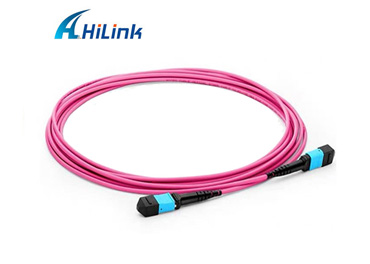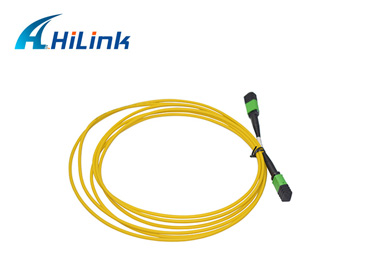How Should I Use Base-24 MTP/MPO Structured Cabling for 40G/100G Networks?
Oct. 28, 2022
As business volumes increase and users demand more bandwidth, large enterprise networks are beginning to upgrade from 10G to 40G to 100G, with Base-24 MTP/MPO structured cabling playing an important role. How much do you know about Base-24 MTP/MPO structured cabling and how does it apply to 40/100G networks? Read this article to find out more.
What is 24-cell MTP/MPO structured cabling?
Base-24 MTP/MPO structured cabling is a high-density cabling solution based on 24-cell MTP/MPO connections. The Base-24 architecture can be achieved with one 24-conductor MTP connector, providing higher density than the Base-24 architecture with three 8-conductor MTP connectors or two 12-conductor MTP connectors. Designed as a single cable terminated with MTP/MPO connectors, the hilink MTP/MPO patch cord cable is used for 40G/100G/200G/400G data centre cabling. With highly integrated design and manufacturing capability, we provide customized MTP/MPO patch cables that are 100% tested to deliver optimal performance and reliability.
MTP/MPO Patch Cord Cables
Base-24 structured cabling solutions in 0/100G networks
Base-24 MTP structured cabling is somewhat more advantageous than traditional single-core duplex fibre optic cabling. While a dual-core duplex LC connector takes up the same space as a single MTP connector, a single MTP connector can support 24 cores, allowing for higher connection density. This is why networks are using Base-24 MTP structured cabling as they grow from 10Gbps to 40G or 100G, making it easier to support more advanced applications (e.g. AR, VR). Base-24 MTP structured cabling based on 24-cell MTP connections can provide different types of solutions for 40G/100G networks. The following three typical Base-24 MTP structured cabling solutions are available.
Base-24 cabling solution 1: MTP patch cable as the main cross-connection
The 24 core MTP fibre patch cable can be converted from 24 core to dual-core by using a 24 core MTP-LC fibre distribution box. The polarity B MTP patchcord manages the port polarity in a similar way to the 8-core/12-core MTP patchcord. Compared to 8-core and 12-core MTP fibre patch cords, 24-core MTP fibre patch cords achieve a higher port density, which is three times higher than 8-core MTP fibre patch cords and twice as high as 12-core MTP fibre patch cords. In addition, the area required to achieve 144 cores is approximately 30% less with 24 core MTP based connectors than with 12 core MTP based connectors, which is why 24 core MTP fibre patch cords are so popular for high-density applications.
MTP/MPO Patch Cord Cables
Base-24 cabling solution 2: LC patchcord-based cross-connect
Unlike the MTP cross-connect, this solution is suitable for applications with limited 24 core MTP fibre patch cords (i.e. no additional 24 core MTP fibre patch cords). To increase network flexibility, and MTP-LC fibre patch box and duplex LC fibre patch cords are used to establish a communication link between two 24 core MTP fibre patch cords, which can be deployed to enable dual and parallel multi-fibre connections on the fibre.
Base-24 cabling solution 3: Using MTP branch patch cords
Unlike solution 1, the MTP branch patch cord and MTP fibre adapter panel in this solution replaces the MTP-LC fibre patch box and LC fibre patch cord combination in solution 1, a change that significantly increases the connection density on the panel. In this solution, the 8-port 24 core MTP fibre adapter panel can support up to 192 fibres. For QSFP applications, the 24 core MTP panel is three times denser than the 8 core MTP panel for the same number of ports (e.g. 8 ports).













